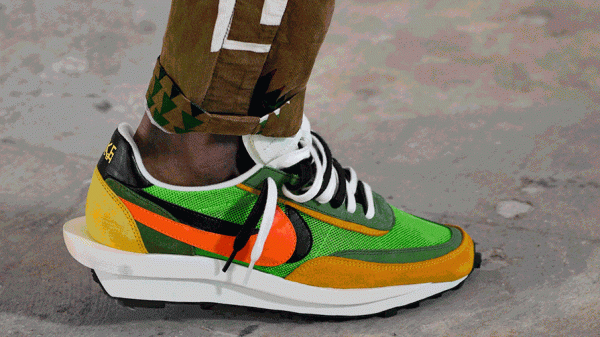
There are hundreds, if not thousands, of Instagram accounts that will gladly serve your timeline a gumbo of custom sneakers, high-fashion runway shots, limited-edition collaboration sneakers, pop-culture ephemera, outlandish Photoshops, rapper paparazzi shots, and, mostly, more sneakers, but every day some three hundred thousand people entrust this duty to @liljupiterr.
The account is run semi-anonymously by a twentysomething New York City man who grew up in Washington Heights. The feed showcases a post-normcore streetwear sensibility; seemingly, anything goes. Kanye West predominates, as does Nike and the work of the designer Virgil Abloh. Demna Gvsalia’s Balenciaga creations and Prada’s neon revival get love, too. But the feed doesn’t help all these things make sense together. Each post contains just a photo, maybe a video—almost none have captions. An adjacent account might be tagged, but the tag is just a clue, not an explanation.
For example, last month, a camouflage Raf Simons bomber, from the designer’s 2001 “Riot, Riot, Riot” collection, sold on the streetwear-resale Web site Grailed for forty-seven thousand dollars. In turn, Lil Jupiter posted a Simons-tagged photo of the jacket and a tagless diptych of Kanye wearing it. But there was no explicit indication of what made the garment so special—not its history, not its price tag. Instead, the truly unaware had to look to the comments, where fashion writers in miniature laid it all out for one another. The account @jaysmoov21_, in three separate comments, teased “If ya know ya know” before clocking the bomber’s début (“2001 f/w collection”) and then giving a more earnest appraisal: “this jacket was so ahead of its time.” One user, @papipeace, didn’t get the hype, so @emxy41 explained it to him: “it’s Raf Simons, Kanye wore it for example and someone bought it for 47k from grailed.” Offering commentary, @max.got.next wrote, “50 fucking k lmaooo.”
On Lil Jupiter’s page, things don’t become cool, they just start showing up, like A$AP Rocky’s bulbous Under Armour skate sneaker. And it’s never clear when something falls from grace; it just disappears, like A$AP Rocky’s bulbous Under Armour skate sneaker. The account is an everlasting stream of things that just are cool. During a July podcast interview with the sneaker brand K-Swiss, Lil Jupiter said that the account acquired its vanguard mood-board style because he was trying to promote his own clothing line. The easiest way to get free promo, he realized, was to post photos of his brand alongside images gamed to go viral. His taste in images is the ineffable key to his success: part serendipity, part harvesting from other pages, part marketing (companies sometimes forward images). But he also posts a lot: a typical twenty-four hours might see two or three dozen posts. When Lil Jupiter first started the account, he was uploading a hundred and thirty photos a day. Speaking to K-Swiss, Lil Jupiter said that his cryptic style is a conscious choice to avoid prejudicing followers against certain items or trends. (“I didn’t want to be an influence,” the influencer said.) The account encapsulates the ethos of Instagram’s Explore tab, the platform’s engagement-bait lizard brain.
In its scattershot way, Lil Jupiter is cool as it exists on the street: Vans Old Skools queuing up outside the Supreme store, an Off-White jacket with Travis Scott playing on a Bluetooth speaker in a pocket. Streetwear is a space centered on the tastes of, mostly, young men, and they lend everything they touch the stylish glaze of youth—say, a resurgent, classic skate sneaker, a billion-dollar hype factory, the e-commerce platform Lyst’s “hottest brand in the world,” or a chart-topping rapper—but nobody on the street will tell you what appeals to them and why. (Further, nobody will admit whether such appeal is even warranted.)
In a piece for GQ last year, the writer Jake Woolf explored the phenomenon of the “clout goggles.” The round, white frames were originally designed by Christian Roth, in 1993, and became a signature of the musician Kurt Cobain. When Acne, Saint Laurent, and others began reproducing them in the twenty-tens, the design became ripe for appropriation by young, SoundCloud-based rappers latching onto grunge’s rebel edge. In time, they became associated, among the rappers’ fans, less with Cobain and more with those artists and their scene, a place where stature (“clout”) accrues gradually (or virally) until an act’s algorithmic dominance crowds out context and aesthetic concern. In August, somewhat perfectly, Lil Jupiter posted a photo of a person wearing six pairs of clout goggles at once.
Sourse: newyorker.com






